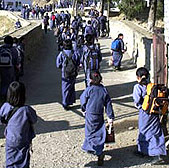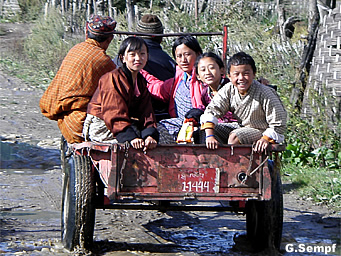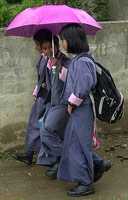 |
Bhutan's
Education |
|
|
 |
|
Closing
the gender gap in the middle and higher secondary level
|
 |
 |
| With
the success in the primary level, education authorities are confident of
narrowing the gender gap in the middle and higher secondary level in the
years to come. Though the numbers at these levels are still comparatively
low, they are nonetheless catching up.
At
the middle secondary level, currently girls make up 46 percent of the total
students of 12,537 indicating a significant rise from just 27 percent in
1992. |
|
In
the higher secondary, girls' constitute 39 percent of the total of 5,830
students showing a rise from 21 percent since 1992. But at the degree level,
girls are still low in numbers. In 1992, girls constituted only 17 percent
from a total of 195 students. The figures for 2003 show an increase to
30 percent from a total of 899 students.
In
the civil service, women constitute about 23 percent of the workforce.
The rest of the women are involved in agricultural activities like working
on family farms or as manual labourers. But of those in the civil service,
the majority are concentrated in low-level jobs with lower levels of education.
Most have dropped out of school for various reasons including parental
pressure to settle down to a family life. But this is also changing according
to the education ministry.
|
The
drop out rates, according to the recent survey conducted by the education
department, are marginally higher among boys. In 2002, the survival of
students in class ten is more among girls with 616 while the boys comprise
528.
According to the education ministry, the success in closing the gender
disparity was by making schools more 'accessible'.
Schools have been constructed
within three kilometres or at an hour's walking distance to encourage girls'
enrolment. This policy will continue to be followed in the current plan.
|
 |
There
is also provisions for boarding facilities in the community primary schools
to ensure more girls to join schools. "But this will need a lot of effort,
considering the pattern of scattered settlements in the remote rural areas,"
said the education spokesman.
 |
| Overall,
134 new schools will be constructed in the Ninth plan with more stress
on enrolment of students at the primary level to ensure a well retainable
number of students at the higher levels. "If we can achieve a near 100
percent primary education, then the other pressing issues can be easily
addressed," said one of the planning officers from the education department.
The government has also been successful in promoting literacy among women,
with the non-formal education (NFE) programme. Around 292 centres have
been established in the country since its inception in 1992. Since 1996,
more than 12,000 have graduated from the NFE with women making up 80 percent
of the total. |
|
Even
though the overall literacy rate in 2002 was estimated at 54 percent, the
literacy rate among women is estimated to be as low as 18 percent, less
than half that of men.
Bhutan
is all set to achieve gender parity in primary level education by 2007
reflecting the government's commitment to the development and empowerment
of women as one of the millennium goals of the Ninth Plan.
Even
though the overall literacy rate in 2002 was estimated at 54 percent, the
literacy rate among women is estimated to be as low as 18 percent, less
than half that of men. Bhutan is all set to achieve gender parity in primary
level education by 2007 reflecting the government's commitment to the development
and empowerment of women as one of the millennium goals of the Ninth Plan.
As Bhutan's first report on CEDAW (convention on the elimination of discrimination
against women) clearly states, the lack of education among women in particular
is a major constraint to full gender equality.
| Contributed
by Karma Choden,KUENSEL, Bhutan's National Newspaper, 2004 |
 |
|





